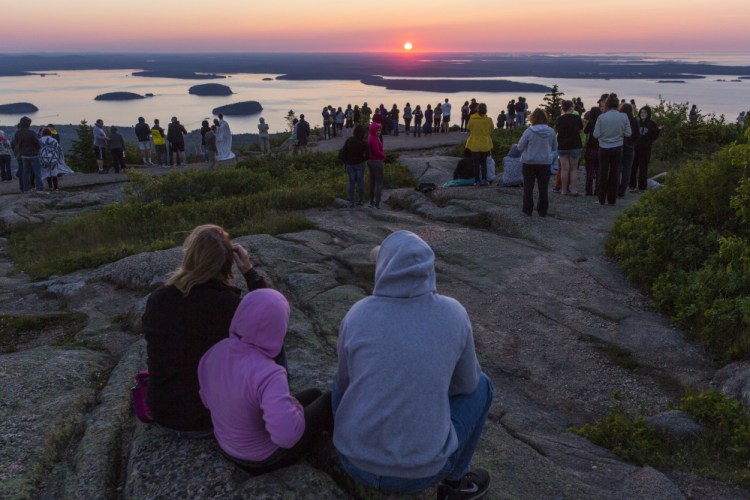AUGUSTA — Maine’s tourism industry saw its revenue increase for the fourth straight year in 2016, growing to $6 billion, a 6 percent bump over 2015.
The 35.8 million visitors who fueled the growth included a resurgence of Canadian vacationers, according to the annual report from the Maine Office of Tourism delivered Wednesday during the Governor’s Conference on Tourism in Augusta.
“It was an extremely strong year last year,” especially with first-time visitors to the state, said Chris Fogg, CEO of the Maine Tourism Association.
Tourism is one of Maine’s largest industries, employing about 106,000 people, or one out of every six jobs in the state. The total economic impact is estimated at $9 billion, and last year tourists paid $596 million in taxes to the state.
The surge continued a four-year growth trend in tourist visits and spending. Visitation has risen almost 30 percent from the 28 million visitors in 2012, and spending grew by about $1 billion over the same period, according to Maine Office of Tourism data.
Visitors spent the most on lodging, retail sales, and restaurants and food.
SURPRISE JUMP IN CANADIAN VISITS
The figures were calculated for the Office of Tourism by DPA Inc., a digital research firm in Kennebunk.
Some of the increase could be attributed to the 100th anniversary of Acadia National Park, which drew 3.3 million visitors last year.
The growth in visitation included an unexpected jump in Canadian tourists after years of decline. The number of Canadians coming to the state grew nearly 10 percent from 4.1 million in 2015 to 4.5 million in 2016. Canadians spent about $975 million in the state, up 15 percent from the previous year.
“Frankly, that was a surprise to us,” said Steve Lyons, acting director of the Office of Tourism. Canada, an important market for Maine tourism, had seen a large decline since 2014 because of a strong dollar. Some tourism businesses also cited Canadians’ concerns about American politics.
The rebound last year might reflect a changing attitude toward travel and spending by Canadians, Lyons said. Some tourists had said they would still visit Maine, but likely wouldn’t spend as much as they might have a few years ago.
“My theory is that the Canadians are getting more comfortable with the exchange rate,” Lyons said. On Wednesday, the Canadian dollar was worth 75 cents U.S.

People enjoy a beautiful day in Old Orchard Beach. The dry weather was good for tourism last summer.
The low exchange rate is not the only factor affecting Canadian tourism, said Jennifer Simmons, a marketing and branding consultant who studied the Canadian market for the tourism office. Her research indicated that although money was an issue, many Canadians didn’t plan on traveling to Maine because they were not familiar with the state. There also was some overlap with what they could find in Canadian provinces and a lack of differentiation between Maine and other New England states, Simmons said.
Overall, to attract more Canadians, Maine should do a better job of making it a specific place people want to visit, Simmons said.
“They need reasons to come,” she said.
NEW MARKETING CAMPAIGN IN 2017
The Maine Office of Tourism is launching a new marketing campaign this year in an effort to continue tourism growth. Called “This is Me,” the intent of the campaign is to frame the state as a lifestyle brand, not just a destination, Lyons said.
“Our goal is for consumers to associate Maine with a distinct way of life,” he said. “We want people to appreciate and crave the way of life we have. We want them to come here and experience it firsthand.”
The marketing will feature everyday Mainers and beautiful scenery, and encourage visitors to come for an authentic experience.
The branding effort includes a new set of TV spots, print publication ads, a redesigned website, sponsorship on National Public Radio, branding on delivery trucks and commuter trains, and increasing the state’s social media presence.
Fogg, from the Maine Tourism Association, said he’s noticed visitors now desire unique experiences that give them a deeper connection to the state than they can get from typical tourist attractions.
“Instead of just eating a lobster in a restaurant, they want to see where the lobster was caught,” Fogg said. “It’s not just in Maine. That’s what people want.”
FERTILE GROUND FOR NEWCOMERS
Maine concentrates its marketing effort on New England, the mid-Atlantic region and Canada, but also internationally, to the United Kingdom and Germany.
Mid-Atlantic metropolitan areas such as New York City, Baltimore, Philadelphia and Washington, D.C., have become a rich vein for Maine tourism, particularly for first-time visitors who tend to stay longer and spend more money, Lyons said. The state hosted about 5 million first-time visitors in 2016, half a million more than in 2015.
Lyons said first-time visitors also tend to return to the state.
“Once you get someone here once, most will want to return,” he said.
Peter McGuire can be contacted at 791-6325 or at:
pmcguire@pressherald.com
Send questions/comments to the editors.



Comments are no longer available on this story